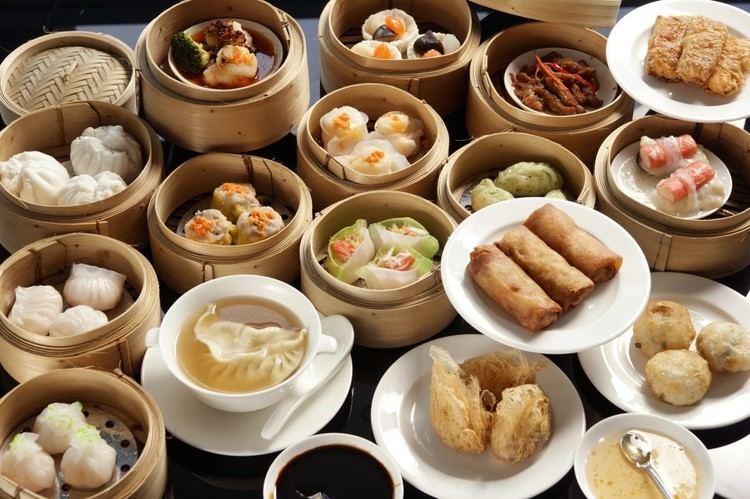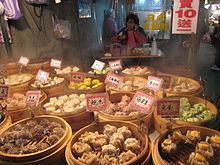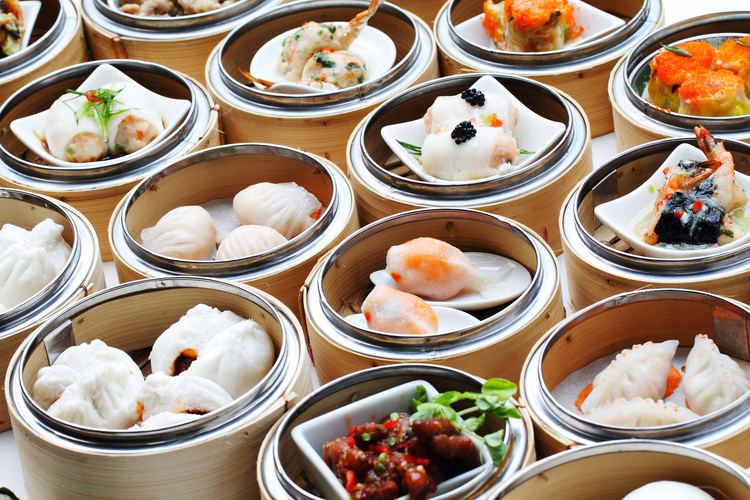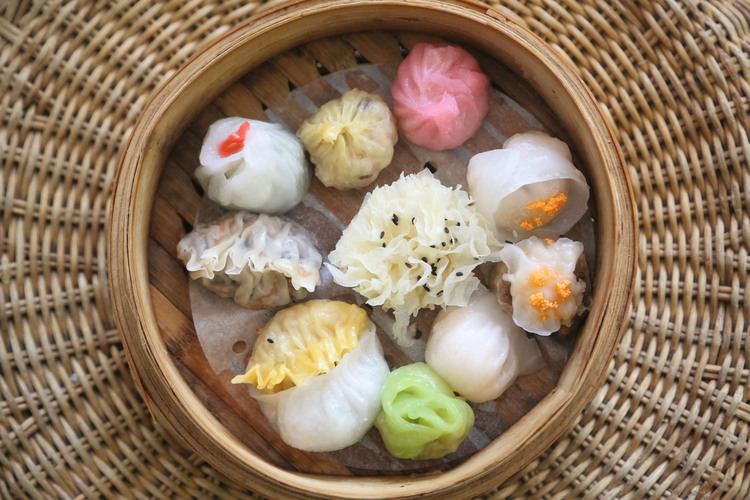Traditional Chinese 點心 Cantonese Yale dím sām Hanyu Pinyin Origin Taiwan | Simplified Chinese 点心 Hanyu Pinyin IPA [tjɛ̀nɕin] | |
 | ||
Similar | ||
11 classic dim sum dishes you must try
Dim sum /ˈdimˈsʌm/ (simplified Chinese: 点心; traditional Chinese: 點心; Cantonese Yale: dím sām; pinyin: diǎnxīn) is a style of Chinese cuisine (particularly Cantonese but also other varieties) prepared as small bite-sized portions of food served in small steamer baskets or on small plates. Dim sum dishes are usually served with tea, and together form a full tea brunch. Dim sum traditionally are served as fully cooked, ready-to-serve dishes. In Cantonese teahouses, carts with dim sum will be served around the restaurant for diners to order from without leaving their seats.
Contents
- 11 classic dim sum dishes you must try
- Top 10 dos don ts when eating dim sum
- History
- Cuisine
- Dishes
- Popular
- Sweets
- Tea service
- Restaurants and pricing
- Etiquette
- Fast food
- References

Top 10 dos don ts when eating dim sum
History

Dim sum is usually linked with the older tradition from yum cha (Chinese: 飲茶; Cantonese Yale: yám chàh; pinyin: yǐnchá; literally: "drink tea"), which has its roots in travelers on the ancient Silk Road needing a place to rest. Thus, teahouses were established along the roadside. An imperial physician in the third century wrote that combining tea with food would lead to excessive weight gain. People later discovered that tea can aid in digestion, so teahouse owners began adding various snacks.

The unique culinary art dim sum originated with the Cantonese in southern China, who over the centuries transformed yum cha from a relaxing respite to a loud and happy dining experience. In Hong Kong, and in most cities and towns in Guangdong province, many restaurants start serving dim sum as early as five in the morning. It is a tradition for the elderly to gather to eat dim sum after morning exercises. For many in southern China, yum cha is treated as a weekend family day. More traditional dim sum restaurants typically serve dim sum until mid-afternoon. However, in modern society, it has become commonplace for restaurants to serve dim sum at dinner time; various dim sum items are even sold as take-out for students and office workers on the go.
Cuisine

A traditional dim sum brunch includes various types of steamed buns such as cha siu bao (a steamed bun filled with barbecue pork), dumplings and rice noodle rolls, which contain a range of ingredients, including beef, chicken, pork, prawns, and vegetarian options. Many dim sum restaurants also offer plates of steamed green vegetables, roasted meats, congee and other soups. Dessert dim sum is also available and many places offer the customary egg tart. Dim sum is usually eaten as breakfast.

Dim sum can be cooked by steaming and frying, among other methods. The serving sizes are usually small and normally served as three or four pieces in one dish. It is customary to order family style, sharing dishes among all members of the dining party. Because of the small portions, people can try a wide variety of food.
Dishes
Dim sum brunch restaurants have a wide variety of dishes, usually several dozen. Among the standard fare of dim sum are the following:
Popular
Sweets
Tea service
The drinking of tea is as important to dim sum as the food. The type of tea to serve on the table is typically one of the first things the server asks dining customers. Several types of tea are served during dim sum :
Chrysanthemum tea – Chrysanthemum tea does not actually contain any tea leaves. Instead it is a flower-based tisane made from chrysanthemum flowers of the species Chrysanthemum morifolium or Chrysanthemum indicum, which are most popular in East Asia. To prepare the tea, chrysanthemum flowers (usually dried) are steeped in hot water (usually 90 to 95 °C (194 to 203 °F) after cooling from a boil) in either a teapot, cup, or glass. However, Chrysanthemum flowers are often paired with Pu-erh tea, and this is often referred to as guk pou (Chinese: 菊普; pinyin: jú pǔ; Cantonese Yale: gūk póu).
Green tea – Freshly picked leaves only go through heating and drying processes, but do not undergo oxidation. This enables the leaves to keep their original green color and retain most natural substances like polyphenols and chlorophyll contained within the leaves. This kind of tea is produced all over China and is the most popular category of tea. Representative varieties include Dragon Well (Chinese: 龍井; pinyin: lóngjǐng; Cantonese Yale: lùhngjéng) and Biluochun from Zhejiang and Jiangsu Provinces respectively.
Oolong tea – The tea leaves are partially oxidized, imparting to them the characteristics of both green and black teas. Its taste is more similar to green tea than black tea, but has a less "grassy" flavor than green tea. The three major oolong-tea producing areas are on the southeast coast of China e.g. Fujian, Guangdong and Taiwan. Tieguanyin (Chinese: 鐵觀音; pinyin: tiěguānyīn; Cantonese Yale: titgūnyām), is one of the most popular choice of tea. It is originally cultivated in Fujian province and is a premium variety of Oolong tea with delightful fragrance.
Pounei tea (Cantonese) or Pu-erh tea (Mandarin) – The tea has undergone years of fermentation, giving them a unique earthy flavor. This variety of tea is usually compressed into different shapes like bricks, discs and bowls.
Scented teas – There can be various mixtures of flowers with green tea, black tea or oolong tea. Flowers used include jasmine, gardenia, magnolia, grapefruit flower, sweet-scented osmanthus and rose. There are strict rules about the proportion of flowers to tea. Jasmine tea is the most popular type of scented tea, and is often the most popular type of tea served at yum cha establishments.
The above teas are produced in most of China. Chinese tea bushes (Camellia sinensis) are cultivated in the mountain areas of tropical and subtropical regions or wherever there is a proper climate, sufficient humidity, adequate sunshine and fertile soil. Chinese tea is classified in many ways, e.g., quality, method of preparation or place of production. The main processing methods include oxidation, fermentation, heating, drying and addition of other ingredients like flowers, herbs or fruits. These help to develop the special flavor of the raw tea leaves.
Restaurants and pricing
One aspect unique to dim sum is its method of serving in specialized dim sum brunch restaurants or teahouses. Here, dishes are pushed around the restaurant in steam-heated carts, with servers offering the dishes to customers. Pricing of dishes at these types of restaurants may vary, but traditionally the dishes are classified as "small", "medium", "large", "extra-large", or "special". For example, a basket of dumplings may be considered a small dish, while a bowl of congee or plate of lo mai gai may be considered a large dish. Dishes are then priced accordingly by size, with orders typically recorded with a rubber stamp onto a bill card that remains on the table. Servers in some restaurants use distinctive stamps, so that sales statistics for each server can be recorded. Menu items not typically considered dim sum fare, such as a plate of chow mein, are often available; they are typically branded as "kitchen" dishes on menus and are individually priced.
As a means of attracting customers at less busy times, many restaurants have promotional periods on certain days, usually in the early morning or late afternoon. This typically involves charging a fixed price for certain dishes. Typically, the "small", "medium" and "large" items are all charged at the usual price for "small" items; the rule would not apply to "extra large", "special", or "kitchen" dishes. In some places the "tea fee" may also be waived, or a discount be placed on the entire order. Where such periods exist the bill card would have a designated section that allows the items that were ordered during the period and to be easily recognized and charged appropriately.
Another way of pricing the food consumed is to use the number and color of the dishes left on the patron's table as a guide, similar to the method used in some Japanese conveyor belt sushi restaurants. Some newer restaurants offer a "conveyor belt dim sum" format, similar to the conveyor belt sushi eating places.
Other Chinese restaurants may not offer dim sum on moving platforms, and instead take orders, generally on a pre-printed sheet of paper, and serve à la carte, in a manner similar to a Spanish tapas restaurant. Prices of each dim sum dish may then vary depending on the actual dish ordered. This procedure may be used at less busier times in specialized restaurants, as it saves time and resources by chefs not having to anticipate which dishes would be ordered and prepare them in advance; though for the customer, it may take longer for the dishes to be delivered after ordering.
Etiquette
There are common tea-drinking and eating practices or etiquette that Chinese people commonly recognize and use. These are practiced not only during dim sum meals but during other types of Chinese meals as well.
It is customary to pour tea for others before filling one's own cup during a meal. When pouring tea for people on one's left side, the right hand should be used to hold the teapot and vice versa. A common custom among the Cantonese is to thank the person pouring the tea by tapping the bent index finger (if you are single), or by tapping both the index and middle finger (if you are married), which symbolizes the gesture of bowing.
This custom is said to be analogous to the ritual of bowing to someone in appreciation. The origin of this gesture is described anecdotally: The Qianlong Emperor went to yum cha with his friends, outside the palace; not wanting to attract attention to himself, the Emperor was disguised. While at yum cha, the Emperor poured his companion some tea, which was a great honor. The companion, not wanting to give away the Emperor's identity in public by bowing, instead tapped his index and middle finger on the table as a sign of appreciation.
Given the number of times tea is poured in a meal, the tapping is a timesaver in loud restaurants or lively company, as an individual being served might be speaking to someone else or have food in their mouth. If a diner does not wish a refill being offered at that time, the fingers are used to "wave off" or politely decline more tea. This does not preclude taking more fresh hot tea at a later time during the meal.
Leaving the lid balanced on the side of the tea pot is a common way of attracting a server's attention, and indicates a silent request that the tea pot be refilled.
Fast food
Instant dim sum as a fast food has come onto the market in Hong Kong, Mainland China, Taiwan, Indonesia, Singapore, and Malaysia. People can enjoy snacks after a three-minute defrosting or reheating of the instant dim sum in a microwave oven.
In many cities, "street dim sum" is sold from mobile carts and usually consists of dumplings or meatballs steamed in a large container and served on a bamboo skewer. The customer can dip the whole skewer into a sauce bowl and then eat while standing or walking.
Dim sum can be purchased from major grocery stores in most countries with a Chinese population. These dim sum can be easily cooked by steaming or microwaving. Major grocery stores in Hong Kong, Philippines, Singapore, Taiwan, Mainland China, Indonesia, Malaysia, Brunei, Thailand, Australia, United States, and Canada have a variety of frozen or fresh dim sum stocked at the shelves. These include dumplings, shaomai, bao, rice noodle roll, turnip cake and steamed spare ribs.
In Singapore, as well as other countries, dim sum can be purchased from convenience stores, coffee shops and other eateries. There is halal certified dim sum available (with chicken taking the place of pork) which is very popular in Malaysia, Indonesia and Brunei.
